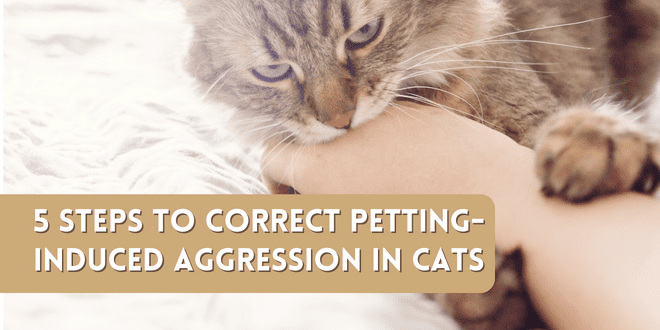
Listen to the audio version of this article
I’m getting more and more calls from cat parents who are confused about why they’re getting bitten when petting their cats. Things start out just fine and then suddenly, without warning, the cat turns around and lashes out with teeth or claws.
In many cases, the behavior being displayed is called petting-induced aggression. It seems to come out of nowhere from the cat parent’s point of view. A quiet session of petting and affection suddenly turns violent as the cat sinks his teeth into the very hand that’s stroking him.
Here are five steps for identifying and correcting petting-induced aggression:
1. Veterinary Visit for Your Cat
Just to be on the safe side, have your cat examined by the veterinarian because the sudden aggression may be the result of an underlying medical issue causing pain. He may be fine when you pet him in some locations on his body but if you hit that tender spot, he may react aggressively. Go to the veterinarian to make sure there isn’t an injury you’re unaware of or some unseen condition such as arthritis, dental problem, abscess, etc.
2. Did You Interpret Your Cat’s Mood Correctly?
Sometimes the reason your cat may bite when you’ve been petting him is that you misinterpreted his intention when he approached in the first place. His approach may actually have been a play solicitation and not a desire to engage in physical affection. Perhaps he was being as tolerant as possible by allowing you to stroke him a few times but if he was in play-mode and not affection-mode then the stroking just served to increase his stimulation.
3. Read Your Cat’s Body Language
Even though it may seem as if your cat displayed aggression without any warning, there are usually several body language signals given off that cat parents might ignore. If you’re not paying attention to your cat as you pet him, it may seem as if his attack is out of blue, but from his point of view, he clearly gave numerous warnings. If you have a cat who has displayed petting-induced aggression previously then you need to watch body language as you pet him. You can’t become distracted or you’ll easily miss those physical warning signs again. Cats are masters of body language communication and often give multiple indications of their desire to engage or avoid.
Some body language signals that indicate your cat is reaching tolerance levels can include:
- Cessation of purring
- Tail lashing
- Tail thumping
- Skin twitching
- Shifting body position
- Meowing
- Growling
- Ears in airplane mode
- Ears flattened back against head
- Cat looking back at your hand
- Dilated pupils
4. End on a Positive Note with Your Cat
The way to help a cat feel more comfortable with being petted is to pay attention to his tolerance level so you can stop petting well in-advance of an attack. Pay attention to body language and stop petting before the warning signals appear. For example, if you know you can typically pet your cat for about three minutes before he bites, then in order to keep this a positive experience, stop petting after about a minute-and-a-half. Leave your cat wanting more. When you stop petting while the experience is still positive then it breaks that chain where your cat feels the only want to end the session is to display aggression. At the very least, stop petting the second you see the first body language red flag.
Pay attention to where on the body your cat likes to petted and where he doesn’t. He may enjoy being petted on the back of the head but not at the base of the tail. Petting in some areas may actually cause too much stimulation. In general, most cats enjoy being petted around the head and not toward the base of the tail. When two cat friends engage in the social behavior of allogrooming, they often stick to the head area.
5. Never Punish Your Cat
If you yell at, hit, or chase your cat for biting you during a petting session then you will only accomplish one thing – you’ll increase his fear of you and that’s a surefire way of damaging the human/cat bond. He isn’t biting you because he’s mean; he’s biting because he feels he has no other option. From his point of view all other forms of communicating with you have failed. He was left with no choice. If you watch body language, pet in preferred body locations, and stop petting long before he reaches his tolerance peak, you stand a very good chance of changing his mind about physical contact.
Need More Information?
For more information on cat behavior and training, refer to the books by Pam Johnson-Bennett. Pam’s books are available at bookstores and online. We’ve included links to Amazon here on our website.
If you have a question regarding your cat’s health, please contact your veterinarian. This article is not intended as a replacement for your cat’s veterinary care.
 Problem Solving & Advice by Pam Johnson-Bennett Cat Behavior Expert & Best-selling Author
Problem Solving & Advice by Pam Johnson-Bennett Cat Behavior Expert & Best-selling Author



